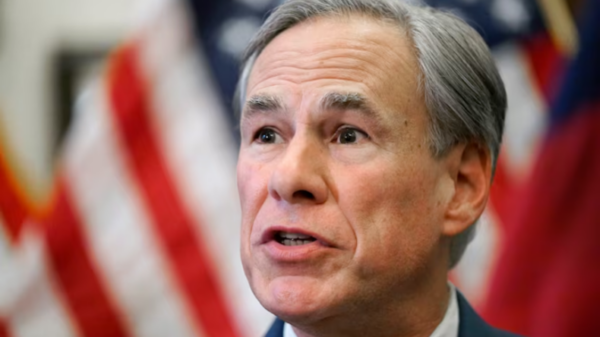Electricity demand was far below ERCOT’s projections in the winter storm that so far has brought more anxiety than actual outages.

AUSTIN — Texas’ grid held up to this week’s winter storm, withstanding the biggest test the state’s electricity system has seen since last year’s deadly freeze plunged the state into darkness in outages that killed more than 240 people.
By 5 p.m. Friday, fewer than 10,000 customers were without power in localized outages that cut power to smaller areas of the state, according to the website PowerOutage.us, which tracks utility outage data. At no time during the 48-hour freeze did the freezing weather force the grid’s operator, the Electric Reliability Council of Texas, to cut power to any part of the state, even as demand soared.
“The Texas electric grid is more reliable, and more resilient than it has ever been,” Gov. Greg Abbott said during a briefing Friday morning at the state’s emergency operations center in Austin.
The demand on Texas’ grid topped out at about 69 gigawatts Friday morning. Demand fell short of projections and never came near the record levels seen during last year’s winter storm that brought the grid to a near collapse.
No significant outages at power plants were reported during the storm, and the amount of power plants forced offline remained below ERCOT projections, ERCOT’s interim CEO Brad Jones said.
“We believe the weatherization and our preparations have been extraordinary and are pretty successful,” Jones said.
Wind energy performed above expectations, at times pumping 70% more energy than expected into the grid, according to ERCOT projections. That production leveled off on Friday, but still continued to outperform ERCOT’s forecast.
Some stresses were felt in natural gas production, but Texas Railroad Commissioner Christi Craddick said those fluctuations were expected and did not create a lack of supply.
“We are operating as expected with natural gas coming into the system,” Craddick said. “Fluctuations in production have been brief and expected.”
Many parts of Texas saw ice thawing as temperatures crept above freezing Friday afternoon. However, another freeze is forecast overnight, which is keeping ERCOT on its “highest level of alert,” Jones said.
ERCOT projections on Friday afternoon showed demand reaching 63.4 gigawatts Saturday morning. Abbott said the state will have plenty of power reserves available, with projections showing enough reserves to power more than 3 million homes.
P.J. Popovic, CEO of the Houston-based retail renewable energy provider Rhythm Energy, said the grid’s performance showed that ERCOT pulled out all the stops to ensure the grid had plenty of capacity available during the freeze. With temperatures warming and peak demand behind Texas, residents can begin to relax.
“We are pretty confident at this point that we have weathered this winter blast,” Popovic said.
Peter Lake, chairman of the grid’s regulator the Public Utility Commission of Texas, credited the reforms his agency put in place in the past year. Lake, an Abbott appointee to the board which oversees ERCOT and electricity regulations, became the leader of the PUC after every member of the board and the entire leadership of ERCOT was either fired or resigned in the political bloodbath that followed the 2021 freeze.
“The historic reforms that we’ve implemented at the direction of the Legislature and the governor mean that we have more power available than before, more backup for generators than before and more reliability than ever before, especially in severe winter weather events like this,” Lake said.
Under a massive new law passed in the aftermath of the 2021 winter storm, state lawmakers mandated all power plants become weatherized. The Public Utility Commission enacted winterization rules in December and plants appear to have rapidly winterized following the new regulations. Recent inspections at many of the power plants ERCOT identified as most vulnerable to winter weather indicated near universal compliance to the new rules, according to a Jan. 18 report on winterization.
The Public Utility Commission has also remade some aspects of Texas’ competitive energy market with new pricing guidelines in place that were designed to move the system away from what Lake has characterized as a “crisis-based model” that encouraged power generators to keep Texas on the knife’s edge between reliability and collapse.
The full market revamp remains a work in progress, but Abbott said that new incentives encouraged power plants to have alternative fuels on site, such as fuel oil, worked. Abbott also credited ERCOT altering maintenance schedules to ensure more power plants were online in anticipation of inclement weather.
Concerns linger
While the grid’s overall performance passed the muster of state leaders, lingering questions remain about Texas’ natural gas infrastructure.
Unlike Texas’ power plants, gas production facilities likely won’t have any weatherization requirements in place until 2023. During 2021′s freeze, production plunged 50% and some anxiety haunted the sector leading up to this week’s cold snap as analysts at S&P Global Platts saw production declining 10% since the end of January.
The Railroad Commission did put in place requirements for some production facilities to designate themselves as critical infrastructure. According to the commission, more than 2,900 are now on that list, compared to fewer than 100 facilities last year.
Todd Staples, president of the Texas Oil and Gas Association, said the sector’s performance during the storm proved that the industry is proactively hardening its production sites for winter weather.
“The work that oil and gas operators did to prepare for this storm has confirmed that the winterization efforts they are doing works,” Staples said. “The results confirm that keeping power on proves to be the best winterization tool.”
The focus, Abbott said, should be on how Texas’ government is “implementing all the laws that were passed in a bipartisan way. Both Democrats and Republicans supported the reforms that were passed, reforms that have led to a grid that is far more resilient.”
Meanwhile, Democratic gubernatorial hopeful Beto O’Rourke hit the road Friday in El Paso, embarking on a 12-day road trip across 2,100 miles of Texas his campaign is calling the “Keeping the Lights On tour.” O’Rourke will be in Denton on Sunday and is hosting a rally focusing on Texans’ utility bills.
Outside an El Paso Electric substation, O’Rourke said that he would ensure all of Texas’ natural gas infrastructure was winterized and that he would have Texas interconnect with the nationwide grid to prevent a repeat of 2021′s deadly freeze.









You must be logged in to post a comment Login